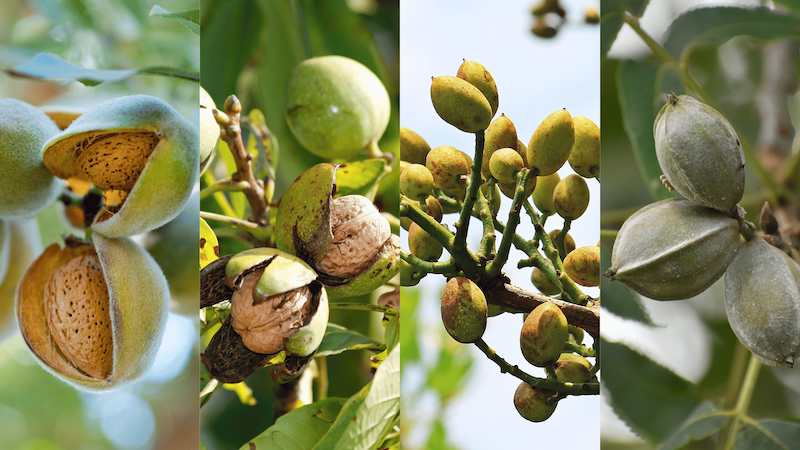The California Nut Industry
In 2017, California Governor, Jerry Brown, declared almonds, pecans, walnuts, and pistachios the official state nuts. The advanced farming techniques, sustainable practices, and commitment to quality have propelled tree nut production to become a multi-billion-dollar industry. California’s high-quality nuts are in demand both domestically and internationally, contributing to the state’s economy, providing employment opportunities, and solidifying its position as a key player in the global nut market.
To better understand this industry and each of these nutritious crops, Harris Woolf Almonds outlines a guide to California nuts and the value they bring to various industries around the world.
Almonds
California dominates the global production of almonds, accounting for approximately 80% of the world’s supply.
Despite the quantities of almonds produced in California, they are not indigenous to the Golden State. According to The Almond Board of California, the start of California almonds can be traced back to the late 18th century when Spanish missionaries planted the first almond trees in the region. The commercial cultivation of almonds began in the mid-19th century when farmers recognized the potential of this crop and the weather allowed for the nut tree to thrive. Advancements throughout the 20th century and beyond have helped California establish itself as the world’s leading producer of almonds. These advancements include crossbreeding, irrigation system improvements, technological advancements, pest management, and more.
The rising global demand for California’s almond crop, both as a nutritious snack and as an ingredient in various products, has also fueled the expansion of almond acreage and production.
Almonds Orchards in California
California’s Central Valley has the best terrain for almond growth. This region is home to around 7,600 almond farms, 90% of which are family-owned, empowering the value of community-driven, multi-generational farming throughout the industry.
Some of the top counties in almond production include:
- San Joaquin
- Stanislaus
- Colusa
- Merced
- Madera
- Fresno
- Kern
The Nutritional Value of California Almonds
The California almond industry’s commitment to producing high-quality almonds ensures that consumers can enjoy the nutritional benefits of these nuts long term. Incorporating almonds into a balanced diet can support heart health, increase protein intake, provide essential nutrients, and offer antioxidant protection. From snacking on whole almonds to utilizing almond products in recipes, the versatility and nutrition of almonds are appreciated in various cultures.
Key Players in the Almond Industry
At the forefront of the industry are the almond growers, who cultivate almond trees, manage orchards, and oversee the entire growing process. As mentioned, many of these orchards are family-owned and operated and range in size. No matter what orchard size or yield, almond growers rely on almond industry associations and processors for representation, resources, and research.
The main governing body and support system throughout the industry is The Almond Board of California (ABC). Established in 1950, the ABC is a nonprofit organization that represents key almond stakeholders while promoting the consumption, production, and sustainability of the crop.
Almond processors, like Harris Woolf Almonds, specialize in transforming raw almonds into value-added products. They can produce whole almonds, almond flour, almond butter, almond milk, almond oil, and other almond-based ingredients. Processors utilize advanced techniques to extract, refine, and process almonds, often catering to specific customer requirements and market demands. The key to successful almond production and sustainability in the industry is building a network of growers and sharing resources that unify orchards and processors.
Walnuts
Like almonds, walnuts are not native to California. They were brought into the state in the late 1700s by the Franciscan Fathers, and the trees flourished in the Mediterranean climate. Today, California is home to some of the most innovative walnut producers in the world, mainly growing in the Central Valley.
One of the pioneers in the walnut industry was Joseph Sexton, who planted one of the first commercial walnut trees in the Sacramento Valley in the 1860s. Sexton’s success in this area moved production toward California’s Central Valley, providing better terrain, irrigation, and pest control, all of which resulted in greater yields and more success in California’s walnut production.
Since 1948, the California Walnut Board has been a state resource for walnut farmers. This board aims to support growers, promote marketing efforts, and enhance the industry’s profitability.
The Value of Walnuts
California walnuts hold significant value around the world due to their nutritional benefits, culinary versatility, and growing global demand.
Recognized for their nutrient-dense profile and health benefits, walnuts are highly sought after by health-conscious consumers. Their culinary versatility allows them to be used in a wide range of dishes, from salads to baked goods to dairy-free products. Embedded in cultural traditions and boasting economic significance, walnuts have secured their position as a valuable commodity in international markets.
Pistachios
The success of California pistachios is rooted in a United States botanist named William E. Whitehouse. Whitehouse planted, experimented with, and scaled pistachio trees in the mid-1900s, commercializing the crop in 1976.
Today, pistachios are an integral part of California’s agricultural landscape. Pistachio farms exist primarily in five counties:
- Kern
- Madera
- Fresno
- Kings
- Tulare
The Value of Pistachios
Pistachios hold significant value globally due to their unique flavor, versatility, and nutritional benefits.
Like most nuts, pistachios are a rich source of protein and healthy fats. They also offer potassium, phosphorus, vitamin B6, thiamine, copper, and magnesium.
Highly prized for their delicious taste, pistachios are a favorite ingredient in a wide range of culinary creations. They offer a delightful combination of nutty, sweet, and savory flavors, enhancing the taste and texture of dishes.
Pecans
Pecans are the only nut native to the U.S. with a rich history that dates back centuries. They were first cultivated by Native Americans, acting as a staple food source and incorporated into various dishes.
In the 18th century, the commercial cultivation and widespread distribution of pecans began. Pecan trees were cultivated on plantations, primarily in the southern states with favorable climate and soil conditions. Pecans became a popular cash crop, and the demand for these delicious nuts grew steadily.
Today, the United States is the world’s leading producer of pecans, with Georgia taking first place. The Farm Progress refers to the California pecan industry as the ‘comeback kid’, after initial challenges in California’s commercial pecan market forced farmers to adjust methods. With these adjustments, California’s pecan production has bounced back and become a major part of the agriculture industry.
The Value of Pecans
Nutritionally, pecans are highly regarded for their health benefits. They are rich in monounsaturated fats, which are beneficial for heart health and can help reduce cholesterol levels. Pecans also provide essential vitamins, minerals, and dietary fiber, making them a nutritious addition to a balanced diet. Their distinct flavor, buttery texture, and crunch make them a sought-after ingredient in various culinary creations.
Sustainability in California Agriculture
With a thriving agricultural community comes challenges in sustainability. Key stakeholders throughout the nut industries, including growers, associations, processors, and consumers, must commit to sustainable efforts and eco-friendly choices. Water supply regulation, invasive species, urbanization, carbon emissions, and pollinator health are all areas to research and innovate.
As a leading wholesale almond-product producer, Harris Woolf Almonds prioritizes sustainability and aims to spread a positive impact throughout California agriculture.
We support our growers with the research and resources needed to be a part of industry advancements. For more information on sustainability initiatives in our grower network and local processing facilities, read our 2022 Impact Report.















